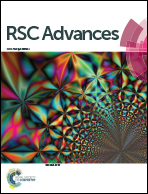La2O3 nanoparticle/polyacrylonitrile nanofibers for bacterial inactivation based on phosphate control†
Abstract
La2O3 nanoparticle-doped PAN nanofiber mats were prepared by an electrospinning process. During the formation process, PAN nanofibers served as the matrix for immobilizing the La2O3 nanoparticles. Due to the great hydrophilicity of PAN nanofibers and the strong chemical affinity of phosphate/lanthanum bonds, the functional composite nanofiber mats exhibited high removal capacity for phosphate with a maximum adsorption capacity of 77.76 mg P per g (La), which guaranteed severe phosphate-deficient conditions. The effects of both the effective nutrient (phosphate) starvation and the close contact of E. coli with composites led to great antibacterial activity. The nutrient starvation (indirect antibacteria) was proved to be the primary mechanism. The intimate contact (direct antibacteria) was revealed as a supplementary role that only induced cell death without the existence of phosphate. The results demonstrated the feasibility of this antibacterial strategy through phosphate-starvation. In addition, the composite nanofiber mats implied a practical application by virtue of a simple fabrication and easy separation from the heterogeneous systems after using.


 Please wait while we load your content...
Please wait while we load your content...